Description and Requirements
The Book
Bibliography
Syllabus
 Introduction
Introduction The Great Pyramid
The Great Pyramid Music of the Spheres
Music of the Spheres  Number Symbolism
Number Symbolism  Polygons and Tilings
Polygons and Tilings  The Platonic Solids
The Platonic Solids  Roman Architecture
Roman Architecture  Number Symbolism in the Middle Ages
Number Symbolism in the Middle Ages  The Wheel of Fortune
The Wheel of Fortune  Celestial Themes in Art
Celestial Themes in Art  Origins of Perspective
Origins of Perspective  What Shape Frame?
What Shape Frame?  Piero della Francesca
Piero della Francesca  Leonardo
Leonardo Façade measurement by Trigonometry
Façade measurement by Trigonometry  Early Twentieth Century Art
Early Twentieth Century Art  Dynamic symmetry & The Spiral
Dynamic symmetry & The Spiral  The Geometric Art of M.C. Escher
The Geometric Art of M.C. Escher  Later Twentieth Century Geometry Art
Later Twentieth Century Geometry Art  Art and the Computer
Art and the Computer  Chaos & Fractals
Chaos & Fractals
LEONARDO
"Non mi legga chi non e matematico."
(Let no one read me who is not a mathematician.)
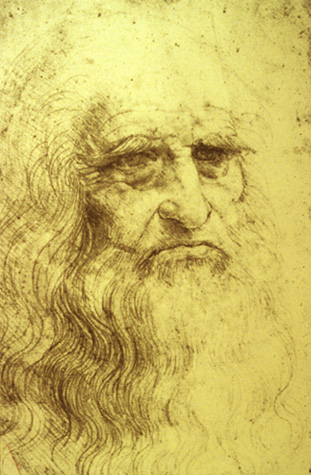
Slide 15-1: Self Portrait
| Outline: | |
| The Ultimate Renaissance Man | |
| Leonardo's mathematics | |
| Leonardo's Treatise on Painting | |
| Perspective | |
| Summary |
The Ultimate Renaissance Man
Slides 15-2 Leonardo's Birthplace
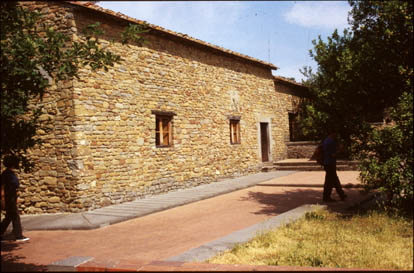
Leonardo (1452-1519) is considered by many the ultimate renaissance man, skilled in mathematics, philosophy, civil and military architecture, engineering, painting, sculpture, science, music, invention, and the design of weapons.
Slide 15-6: Lorenzo de' Medici. The Magnificent. Terra cotta bust, Verrocchio.
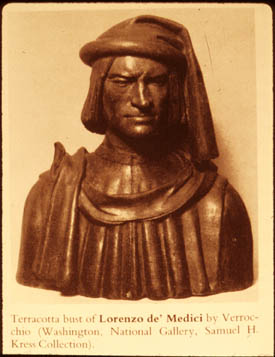
Leonardo got his start in Florence, but he left that city in 1482, at the age of 30. Why did he want to leave Florence, and why did Lorenzo let him go and make no attempt to get him back once he was famous?
Lorenzo encouraged exportation of Florentine artists in 1480's. It provided prestige and opportunities for exchanges, but this exodus caused Florence to lose the artistic lead it had held for 200 years.
Other reasons for leaving were severe competition, war, plague, taxation. Further, Leonardo had contempt for the doctrines of Savonarola. Finally, Leonardo had no use for Lorenzo and his neoPlatonists.
The Plato Academy
Slide 15-7: Bust of Ficino, by Andrea Ferrucci da Fiesole, in Florence Duomo. Encyc Ren p. 134
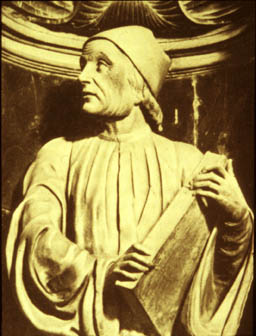
Most humanists of the Renaissance had a reverence for Plato, and Cosimo de Medici (Lorenzo's grandfather) resolved to make Florence the center of neoPlatonic learning.
In 1463 Cosimo commissioned Marsilio Ficino to translate Plato's Dialogues into Latin, and had a villa built for him at Careggi in which to work. There Ficino burned an eternal lamp in front of a statue of Plato. He could recite an entire Plato dialog but, according to his nieces, couldn't remember where he put his slippers. Ficino was the first of the so-called Plato Four, the main members of the Medici Platonic Academy, which attracted scholars form all over Italy.
Another was Cristoforo Landino, well-known commentator on Virgil, Horace, and Dante, who looked upon Lorenzo the magnificent as Plato's "Ideal ruler."
Slide 15-8: Poliziano, with Lorenzo's son Piero, From Ghirlandaio's fresco cycle in S. Trinita. Encyc. of Ren. p. 260
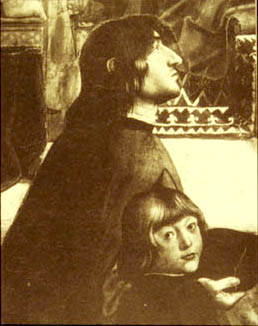
A third member was Angelo Poliziano, ugly but brilliant, publishing in Latin by age 10 and translated Homer by 16. And the fourth was Pico della Mirandola, young and attractive, read and wrote in 22 languages, aspired to hold in his mind the totality of human learning. He wanted to reconcile all religions, and attempted to reconcile the creation stories in the Timaeus with Genesis.
These four, the most brilliant minds in Italy, would meet in Lorenzo's studiolo, often inviting Michelangelo.
Leonardo vs. the NeoPlatonists
Legend has it that Leonardo was Raphael's model for Plato in the School of Athens, and he would probably been appalled if he knew of this, for the scientific and artistic Leonardo apparently had little sympathy for the lofty poetic Neoplatonism of the Medici court.
Rohatyn writes, Platonic aesthetics he had no time for; he was too busy creating perfection to sit back and idly contemplate it.
And the man often called the greatest genius of all time felt inadequate!
Leonardo, says Italo Calvino, had a difficult relationship with the written word. He was, in his own estimation, an omo sanza lettere, an unlettered and uneducated man. His knowledge, continues Calvino, was without equal in the world, but his ignorance of Latin and grammar prevented him from communicating in writing with the learned men of his time. Learned men looked down on him, so he in turn shunned their ideas about the route to wisdom, preferring observation, experience, and experiment to contemplation. In his notebooks he wrote;
"I am fully conscious that, not being a literary man, certain presumptuous persons will think that they may reasonable blame me; alleging that I am not a man of letters. Foolish folks! do they not know that I might retort ... that they, who deck themselves out in the labors of others will not allow me my own ... they do not know that my subjects are to be dealt with by experience
rather than words, and experience has been the mistress of those who wrote well."
The phrase ... they who deck themselves out in the labors of others must certainly be a jab at the neoPlatonists, decking themselves out in the labors of Plato.
Leonardo's Mathematics
Non mi legga chi non e matematico. "Let no one read me who is not a mathematician."
Recall Plato's inscription over his academy door, Let no one enter who is lacking in geometry? This phrase taken from Leonardo's notebooks gives some idea of the importance he placed on mathematics. He also wrote, "There is no certainty in sciences where one of the mathematical sciences cannot be applied ... .
The Platonic Solids
Slide 15-11: Leonardo's Illustrations, Reti p. 70
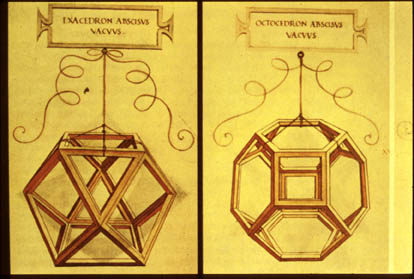
Leonardo studied Pacioli's Summa, from which he copied tables of proportions and multiplication tables. Luca, 7 years older than Leonardo, arrived in Milan in 1496, probably at Leonardo's suggestion, and by 1497 they were collaborating on Pacioli's Divina Proportione, Published in 1509.
Pacioli devoted the entire second part of Divina
Proportione to the Platonic solids.
relating the Platonic solids to the golden ratio like this:
"As God brought into being the celestial virtue, the fifth essence, and through it created the four solids ... earth, air, water, and fire ... so our sacred proportion gave shape to heaven itself, in assigning to it the dodecahedron ... the solid of twelve pentagons, which cannot be constructed without our sacred proportion. As the aged Plato described in his Timaeus."
Here Luca equates God with Plato's divinity, and wraps up the Platonic solids, the golden ratio, the creation of the universe, and God, in one neat package.
This section of the book has little relation to the earlier part and was apparently stolen from Piero and tacked on, without credit. Vasari (1550) had some harsh words for the good friar.
"The man who should have tried his best to increase Piero's glory and reputation (since he learned everything he knew from him), instead wickedly and maliciously sought to remove his teacher Piero's name and to usurp for himself the honor due to Piero alone by publishing under his own name - that is, Fra Luca del Borgo all the efforts of that good old man ... " p. 163
Luca credits Leonardo with the illustrations in De divina proportione. He wrote,
"the most excellent painter in perspective, architect, musician, and man de tutte vertu doctato, Leonardo da Vinci, who deduced and elaborated a series of diagrams of regular solids ... ."
Troubled by his lack of education, Leonardo had an ongoing program of self-study in language and mathematics, studying Pacioli's Summa, and Euclid as well.
In his early forties this obsession with mathematics overtook him, and his notebooks began to fill up with geometrical sketches and diagrams. One page shows his studies of the Rule of Three for a problem about weights in a balance. Elsewhere he gave a proof of Pythagorean theorem and gave a rusty-compass construction of 15°. He found the center of mass of tetrahedron and attempted to duplicate the cube.
To make the rosette patterns and for other geometric studies, Leonardo used and even invented a wide variety of compasses. He designed a proportional compass that would form a figure similar to, and in a given proportion to another figure. Leonardo gives an interesting way to draw an ellipse, and gives drawings of an ellipsograph
Slide 15-12: Ellipsograph, Reti p. 270
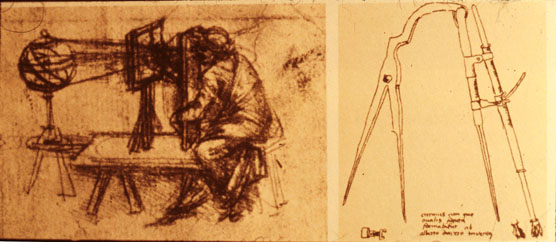
Knots and Meanders
Slide 15-13: Sala delle Asse c.1495-8 text pics Reti p. 37.
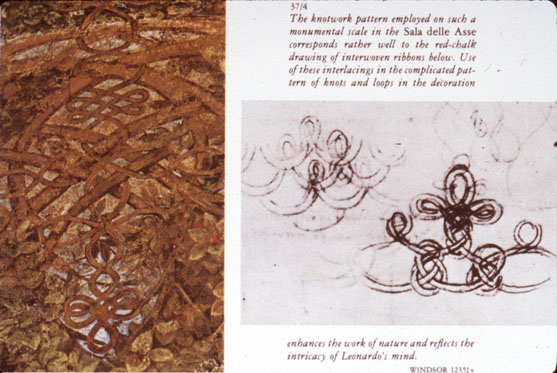
Leonardo's knot designs anticipate the modern interest in knots, in the branch of mathematics called Topology. In his famous arboreal decoration for the ceiling of the Sala delle Asse in Sforza's castle, Leonardo made the branches of the trees form an elaborate system of interlacing, like those in his Academia engravings. To these he has added a single, continuous rope that intertwines throughout the entire vault.
Leonardo's knot patterns are similar to the Celtic designs such as in the Book of Kells, but more probably were inspired by Arabesques from the middle east.
Vitruvian Man
Slide 15-19: Reti p. 79
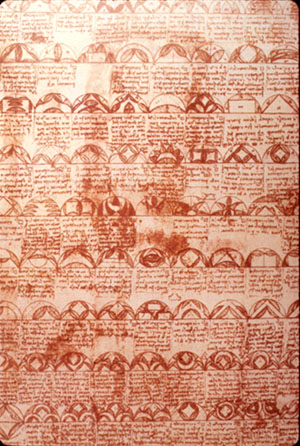
According to Augusto Marinoni, 'The problem in geometry that engrossed Leonardo interminably was the squaring of the circle. From 1504 on, he devoted hundreds of pages in his notebooks to this question of quadrature ... that so fascinated his mentor Pacioli ... While his investigations produced no appreciable gain for mathematics, it did create a multiplicity of complex and pleasing designs."
Slide 15-20: Vitruvian Man Wasserman p. 43
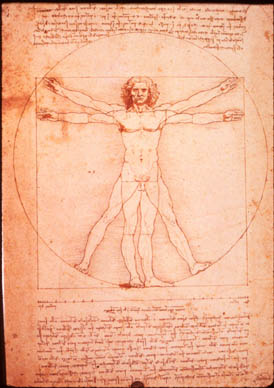
Vitruvius wrote,
"...in the human body the central point is naturally the navel. For if a man be placed flat on his back, with his hands and feet extended, and a pair of compasses centered at his navel, the fingers and toes of his two hands and feet will touch the circumference of a circle described therefrom. And just as the human body yields a circular outline, so too a square figure may be found from it. For if we measure the distance from the soles of the feet to the top of the head, and them apply that measure to the outstretched arms, the breadth will be found to be the same as the height ..."
Clark writes, "It is impossible to exaggerate what this simple-looking proposition meant to the men of the Renaissance. To them it was far mor than a convenient rule: it was the foundation of a whole philosophy. Taken together with the musical scale of Pythagoras, it seemed to offer exactly that link between sensation and order, between an organic and a geometric basis of beauty, which was the philosopher's stone of aesthetics."
Chaos & Fractals
Slide 15-30: Deluge, c. 1514. Mannering p. 68
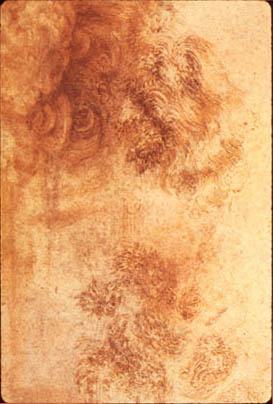
Finally, Leonardo appeared to anticipate the current interest in chaos and fractals with his drawings of turbulence and of the deluge, which he described in great detail in his notebooks. And listen to him talking about the stains on a wall. "I cannot forbear to mention ... a new device for study ... which may seem trivial and almost ludicrous ... [but] is extremely useful in arousing the mind ... Look at a wall spotted with stains, or with a mixture of stones ... you may discover a resemblance to landscapes ... battles with figures in action ... strange faces and costumes ... and an endless variety of objects ... According to Augusto Marinoni, confusedly, like the sound of bells in whose jangle you may find any name or word you choose to imagine.
It almost sound like a description of a fractal pattern.
Leonardo's Treatise on Painting
Slide 15-24: The Trattato
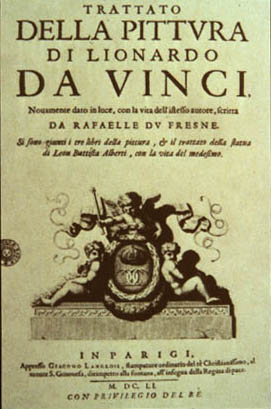
Leonardo da Vinci was of the few great artists to leave a large quantity of writings; large and small notebooks, pocket books, and separate sheets. They were written in Leonardo's famous mirror-image script, with his left hand. All were left to Francesco Melzi, Leonardo's pupil, friend, and heir, who began the frustrating job of editing the jumble of notes with the aim of publishing them.
Melzi's first and only, project (c. 1550) was to compile a treatise on painting, the Trattato, which he never finished, and after Melzi died in 1570 Leonardo's original manuscripts were soon dispersed. Some given away, some stolen, some lost, some sold. Some were cut up for their drawings. Martin Kemp estimates that about three quarters of Leonardo's manuscripts are lost.
Melzi's unfinished manuscript for the Trattato found its way to the Urbino Library of Federigo da Montefeltro in 1472, the library we already mentioned that Piero and Luca used to walk to. After Federigo's death the contents of his library wound up in the Vatican Library under the name Codex Urbinas Latinus 1270, or simply the Codex Urbinas where it lay forgotten until 1817, when Guglielmo Manzi had it published.
The Need for the Book
In the Middle Ages, seven branches of learning were recognized as liberal arts. For a Bachelor of Arts: grammar, logic, and rhetoric: the trivium. For a Master of Arts: geometry, arithmetic, music, and astronomy: the quadrivium. But the visual arts had been classed among the crafts and mechanical arts because they were "handiwork," and lacking a theoretical basis.
Renaissance artists wanted to break this distinction and towards the end of the 15th century the botteghe or workshops of Piero della Francesca, Mantegna, Bramante, Bellini, Verrochio, Pollaiuolo, and so forth, had become small centers of scientific study, where mathematics, anatomy and perspective were learned in an attempt to raise the status of their profession.
There was a lot of empirical knowledge available, but there was no systematic framework in which to organize it. The scientific texts of antiquity and of the Middle Ages were not adequate.
Artists no longer wanted the studio recipes taken from ancient texts. Thus there was a real need for Leonardo's treatise on painting.
The Trattato may be subdivided into the following sections:
The Human Body: proportions, anatomy, motion, posture, expression, decorum, and drapery.
The Depiction of Nature: light, distances, atmosphere, smoke, water, horizons, mountains, plants, and trees.
Painters Practice: ethics, judging works, advice to young painters, the painter's life, the studio, aids, wall painting, invention and composition, allegories and emblems.
The Science of Vision in Painting: properties of the eye and of light, color, perspective of size, color, and disappearance, and light and shade, or chiaroscuro, and linear perspective,
Perspective
Of all the topics in the Tratatto, we are mainly interested in perspective. Leonardo had said that "perspective is the rein and rudder of painting." Invented by Brunelleschi, codified by Alberti and Piero, it was perfected by Leonardo.
Slide 15-25: The Adoration of the Magi, 1481 Reti p. 224
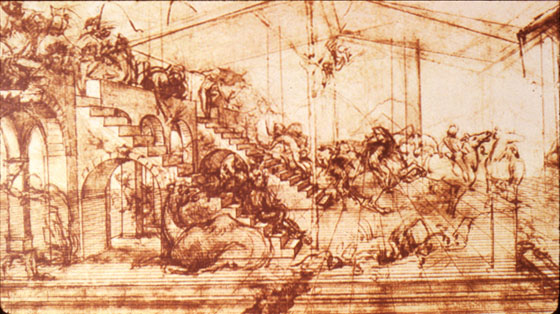
Leonardo's notes on linear perspective are apparently lost, but he made great use of perspective in his own paintings, such as this study of the unfinished Adoration. Note the strict Albertian grid on the pavement.
Slide 15-26: The Annunciation c. 1472 Ufizzi (Cat. # 1074)
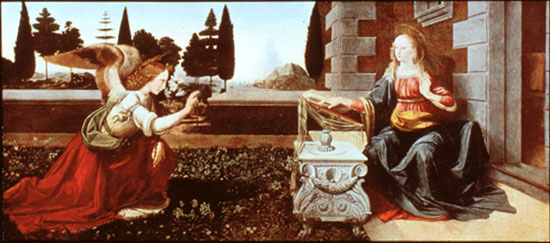 His Annunciation shows a carefully worked out
perspective framework. Incised lines beneath the paint on this wood
panel show his construction. Note though that the Virgin's arm appears
too long. Studies have shown that Leonardo departed from the correct
perspective here for the sake of a more expressive gesture, a common
practice in the Renaissance.
His Annunciation shows a carefully worked out
perspective framework. Incised lines beneath the paint on this wood
panel show his construction. Note though that the Virgin's arm appears
too long. Studies have shown that Leonardo departed from the correct
perspective here for the sake of a more expressive gesture, a common
practice in the Renaissance.
Slide 15-27: The Last Supper. c.1497. Mannering p. 42 (Cat. 3818)
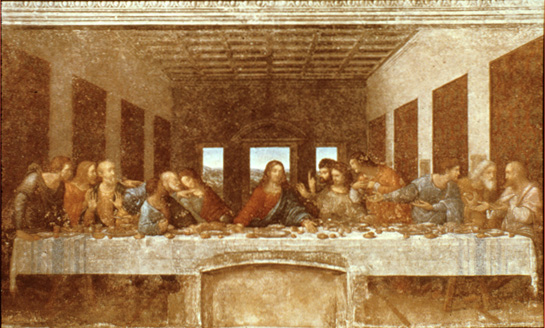
Leonardo's most famous perspective painting, like all the other Last Suppers, this one is placed in a refectory or dining hall, here in the Convent of Santa Maria delle Grazie, Milan. The vanishing point is placed at Christ's right eye, where he dominates the foreground. Even Christ's arms reinforce the perspective, with his arms along the lines of the visual pyramid.
Atmospheric Perspective
Slide 15-28: c. 1508, Nat. Gall.
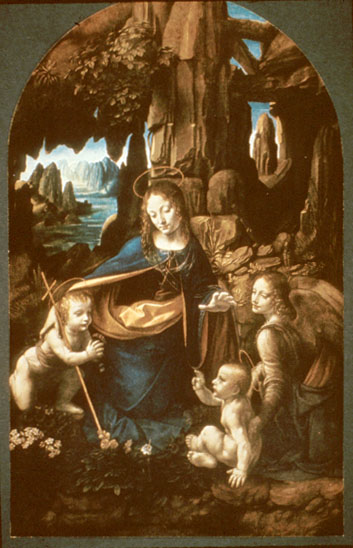
Slide 15-29: Detail Cole p. 28
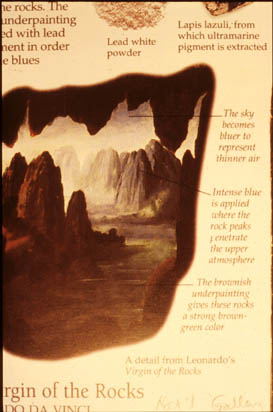
Leonardo also describes another kind of perspective, now called atmospheric perspective. His writings on atmospheric perspective, the perspective of disappearance, have survived. For Kenneth Clark they anticipate the doctrines of impressionism. Distant objects appear smaller, less distinct, paler, and bluer, as seen in The Virgin of the Rocks.
Summary
To summarize, we have three Renaissance men, linked to each other as math teacher to pupil;
Piero taught Luca; Luca taught Leonardo.
They are also linked to each other by the platonic solids: Piero wrote the book on them, Luca stole and published it, Leonardo illustrated it.
In these last two units we've gone from the Early Renaissance of Piero to the high Renaissance of Leonardo; In between stood Pacioli, at the turning point between two worlds. Much of Luca's mathematics was inseparable from religion; an expression of perfection, therefore the divine." But if three to Luca represented the trinity; to Leonardo three was just three!
Listen to Leonardo's rejection of magic: Of all human opinions ... the most foolish is the belief in Necromancy, the sister of Alchemy ... because it brings forth nothing but what is like itself, that is, lies ... [it is] the guide of the stupid crowd which is constantly witness to the dazzling and endless effects of this art ...
Leonardo was a contemporary of Copernicus (1473-1543), and a precursor of Galileo (1564-1642). Coming soon are Kepler (1571-1630), Descartes (1596-1650), Fermat (1601-65), Pascal (1623-65). According to Rohatyn, "Leonardo's insistence on first-hand inquiry ... is one of the sparks that ignite the scientific revolution and bring us, for better or for worse, into the modern era."
Bibliography
Clark, Leonardo da Vinci
Kemp, Leonardo on Painting
J.P. Richter
McCurdey
Cole, p. 24, 25, 28
Baxandall, 109-152
Reti, 56-85, 216-239
Vasari, Chapter on Leonardo
Pedoe, Chap. 3, pp. 82-101
